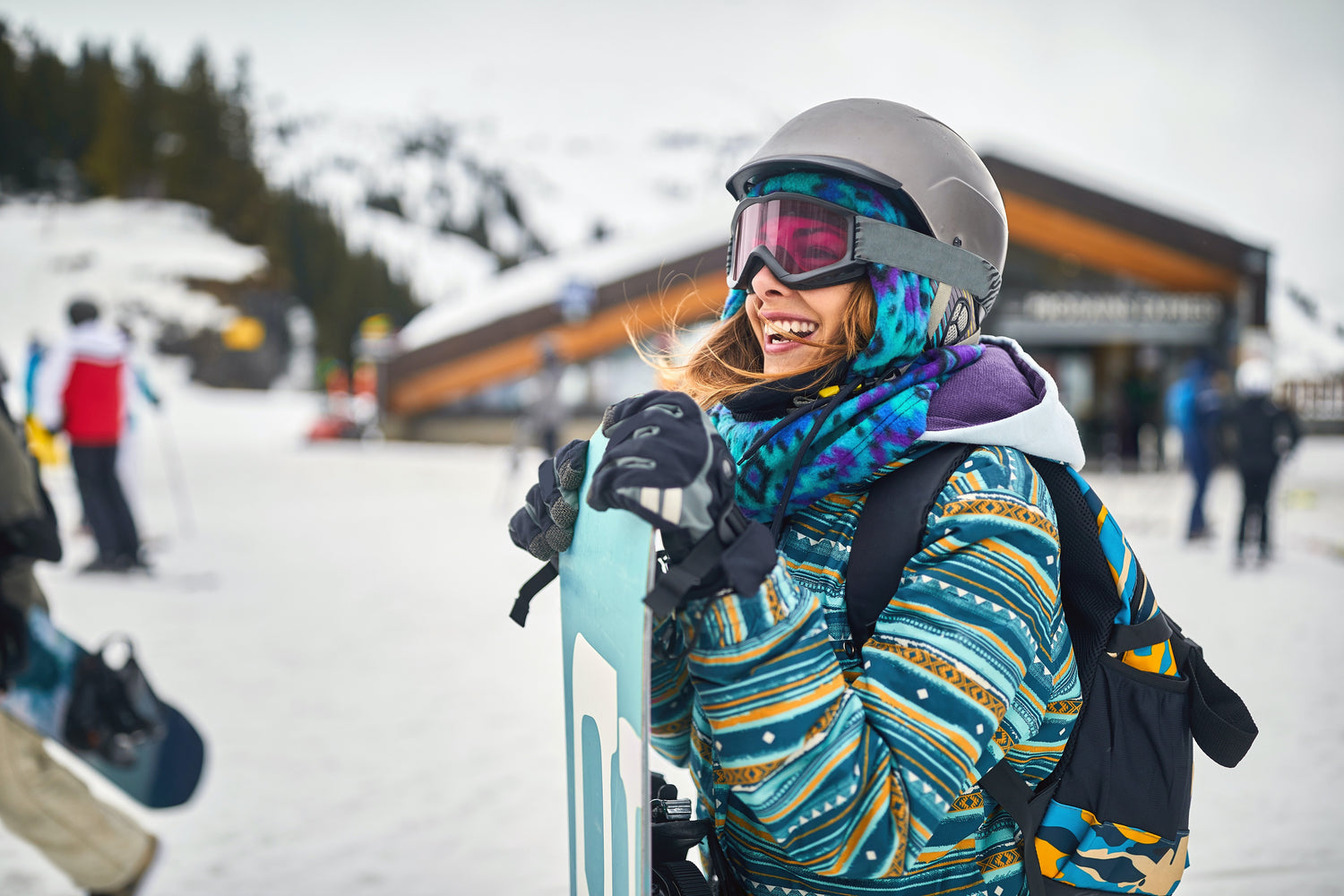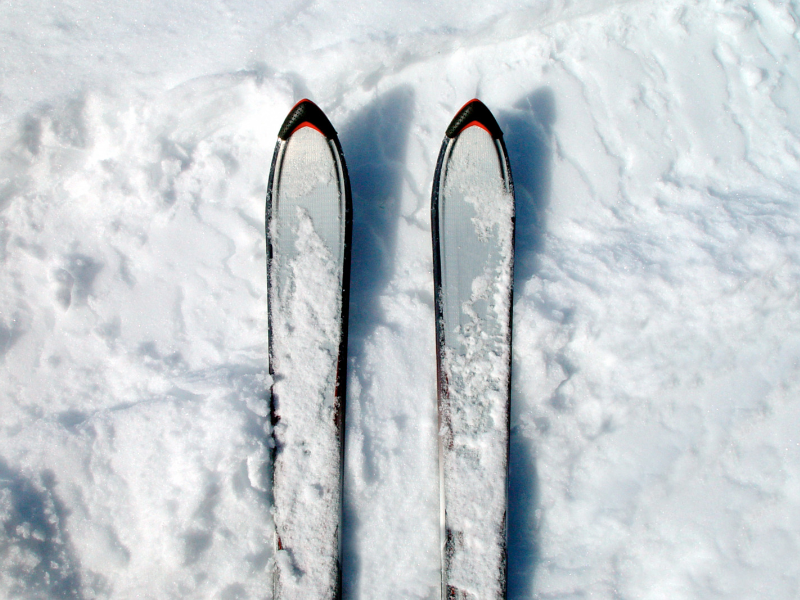What to Wear Snowboarding
So you’re finally taking the plunge and hitting the slopes for the first time? Congratulations, you'll soon experience why millions are obsessed with snowboarding. Since this is your first time, you may be wondering if you'll need to purchase any new clothing for the trip. The short answer is yes...and no.
You most likely have some clothing items already that can be used for snowboarding, but there are some snow-specific items like jackets and pants that you may need to purchase or borrow if you don't already own them.
These items are highly specialized, making it difficult for other apparel you have lying around to stand in as substitutes.
This article centers around maximizing what you already have in your closet for the slopes and guiding you on what's absolutely necessary to purchase or borrow. From your head to your toes, you'll learn what clothing will get the job done right. Most importantly, you'll see clothes you might already have that could work, and what to look for if you need to hit the store to get the rest.
The Basics of Dressing for the Slopes
Before we get into the nitty-gritty, let’s go over some of the basics when it comes to dressing for a day out in the snow.
Protect Your Head and Your Toes
Your helmet will do a great job of protecting your head from impact, and a properly fitting helmet can also help keep your head warm. Still, it's a good idea to wear a balaclava or thin headband or beanie underneath your helmet if you chill easily. These will help make sure your ears stay warm and will be useful for any time you spend outside without your helmet on.
Snowboarding goggles are another critical piece of headgear. They help you see through the glare of the sun and can also keep your face warm. Be sure to grab a pair of goggles before hitting the slopes.
It is crucial to keep your feet warm during a day of snowboarding, and that's where the right pair of socks come in. Make sure you have socks that will protect you against the cold but won't make your feet sweat. Socks made from merino wool are fantastic options. Your socks should come up to your calves to provide full protection against chafing from your boots.
The Goal: Stay Dry & Stay at the Right Temperature
The two most important factors to consider when getting dressed for snowboarding are staying dry and staying at the right temperature—not too cold, not too hot.
If you’re too cold, you risk getting hypothermia and frostbite. If you’re too hot, you'll sweat and your clothes will get wet, which can also make you cold.
To maintain a balanced temperature, you’ll need to dress in layers.
Layering is Everything for Snowboarding
Most people opt for a three-layer system when they head out for a day on the slopes. This includes a base layer, mid-layer, and outer layer.
To layer properly, take into account the climate, difficulty of terrain, type of snow (for instance, eastern US snow is wetter than western US snow), and your general ability—the more you fall, the more susceptible you are to snow and cold.
Based on these factors, you can begin building a system of clothing that aids in keeping you dry and comfortable in the elements.
The base layer sits closest to your skin and helps wick away sweat. The mid-layer provides insulation and warmth. The outer layer protects you from the elements like wind, snow, and rain. Let's take a look at each layer in detail.
Base Layer: Wicks Moisture Away While Keeping You Comfortable
The base layer is so important to the system because it's the only layer that will be in direct contact with your skin. You want this layer to wick away moisture and provide some level of insulation.
Opt for a lightweight, moisture-wicking fabric like merino wool or synthetic fibers. Avoid cotton, as it doesn't wick away moisture and will hold onto sweat.
You want your base layer to fit snugly but not too tightly. If it's too tight, it will be uncomfortable and could restrict movement. If it's too loose, it can bunch up and cause irritation and won't pull moisture away from your body.
For your upper body, you'll want a thermal long-sleeved shirt. For your lower body, you'll want long underwear that fit snugly.
Purchase, Borrow, or Repurpose?
For your base layer, there's a higher chance you have something in your closet that you can use, especially if you play sports or work out in colder temps. Because the base layer is sensitive to fit and is in the business of sweat, this is most likely not something you'll want to borrow.
A lot of athletic training gear today uses materials that work perfectly as a base layer and fit appropriately to your body. There are limitless options for purchasing too, and relative to other layers, they'll be more reasonably priced. Additionally, they don't need to be snowboard-specific.
Mid-Layer: Trap the Heat
The mid-layer works as an insulator, but it also needs some areas that allow heat out so you can cool down when necessary. It's important to find the right balance between insulation and breathability.
Insulation is the name of the game here, so you want to look for materials that excel at retaining your heat. The most common fabrics for mid-layers are wool, fleece, and down. The material thickness is an important consideration. You want a thicker material than your base layer, but not so thick that it constricts your movement.
Finding the correct fit of a mid-layer is also a balancing act. You want your mid layer to conform to your shape, but not as tightly as your base layer. If you have difficulty twisting or moving in it, it may be too tight. If it's too loose, it won't serve its purpose of trapping heat close to your body.
While there are mid-layers for both your upper and lower body, it's most common that you'd wear a mid-layer for your upper body. Opt for pullovers, cardigans, vests, or lighter jackets.
Wearing a neck gaiter goes a long way for keeping your system in place between your head and jacket, so don't forget to grab a gaiter for your first day of snowboarding. They are relatively inexpensive and worth every penny.
Purchase, Borrow, or Repurpose?
All three apply here, but this is another layer that you are likely to have in your closet. Many people have a go-to fall or light winter jacket that will work great as a mid-layer.
Mid-layer apparel is easy enough to borrow since it isn't as form-fitting as a base layer. And if you're looking to purchase something, a fleece pullover or lightweight down jacket are your best options.
Outer Layer: Protects Against Wind, Snow, and Rain
Commonly referred to as your shell, the outer layer is your first layer of defense from the elements. This layer needs to be both waterproof and breathable.
From the outside looking in, the outer layer stops nature from reaching your body, but from the inside out, it's your final stop in regulating your temperature. Proper outer layers will have venting options so you can adjust as needed throughout the day.
Waterproofing, wind proofing, and breathability are the focus, so materials for the outer layers must revolve around those capabilities. DWR is a common term used in outer layers. It stands for Durable Water Repellent, which is an application used on many jackets and pants to avoid water pooling on the fabric. Other common applications and materials to look for are Gore-Tex, Nikwax, Pertex, and synthetic blends of nylon or polyester.
Like your mid-layer, you want your outer layer to have a semi-close fit. This is in part because you don't want fabric flapping around in the wind, but also because you need a full range of motion while snowboarding. If you can't fully extend your arms or legs without having the fabric pull, it's too tight and you'll be restricted. This can have serious consequences when you snowboard.
Outer layer jackets and pants made specifically for snowboarding are plentiful. Browse our selection on the Kenver website to find the style and fit that's right for you.
And don't forget about gloves. They need to be waterproof, wind proof, and breathable. A good pair of gloves is a game-changer, and going without is never a good idea. If you have the wrong gloves for the job, you will know very quickly.
Purchase, Borrow, or Repurpose?
If you don't have pants or a jacket suited for an outer layer, this isn't something you can fake. Don’t try to force your raincoat or other every-day coat to become your snowboarding jacket. A better option would be to borrow from someone. If you do, make sure you try it on with layers underneath to check the fit.
For most people, though, this will be a new purchase and it could be a significant purchase. Proper outer layers generally are the most expensive items for snowboarding apparel, but they are worth the cost—without them, you'd be making a big mistake. This is especially true if it's your first time snowboarding. For beginners, falling in the snow happens.
Without the proper snowboard jacket and pants, you could have a seriously long and rough day on the slopes.
Now You're Ready for the Mountains
When it comes to what to wear snowboarding, there are a few key things to remember.
Your goal is to stay comfortable and dry, and your layers are the ticket here. For the base layer, focus on moisture wicking. For your mid-layer, pick a fabric that does a great job at insulating. And for your outer layer, go with snow-specific jackets and pants that prevent moisture from entering and can block the wind.
And while you might be able to find base layer and mid-layer clothing items in your current closet, if you don't have snow-specific outer layer apparel already, this is something you need to purchase or borrow before your trip.
With these guidelines in mind, you should be able to put together a solid outfit to wear on your next snowboarding trip.



